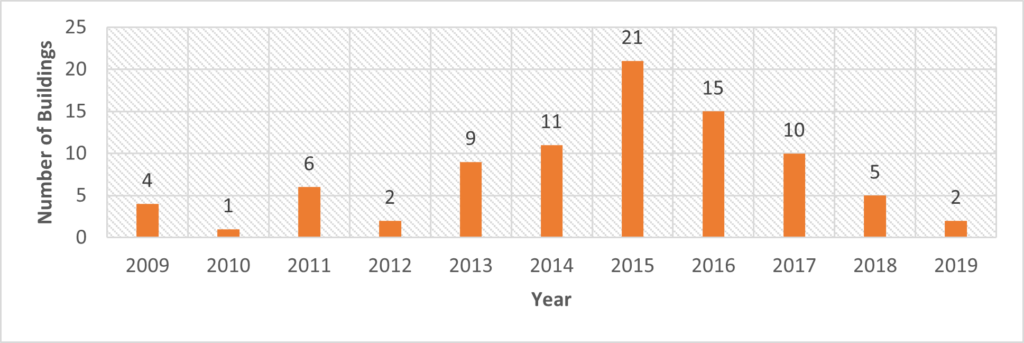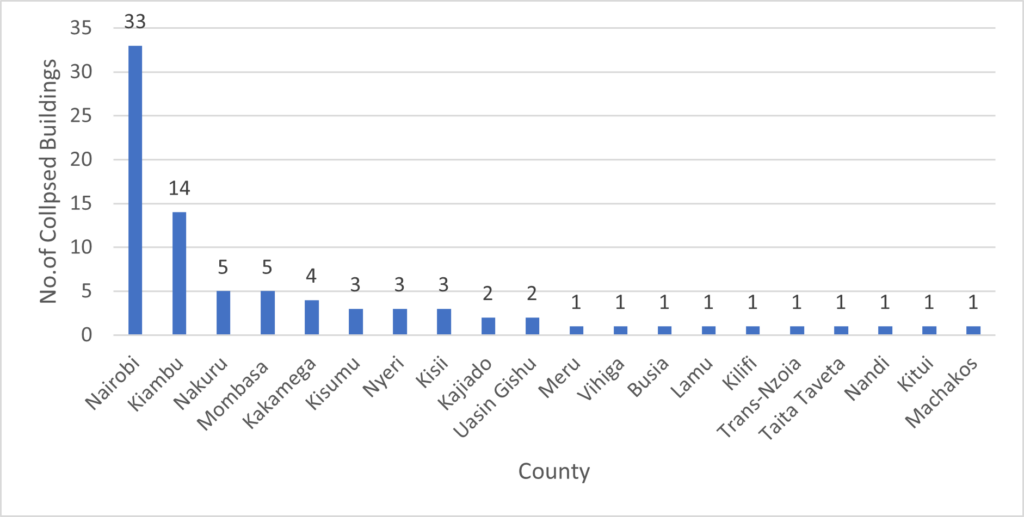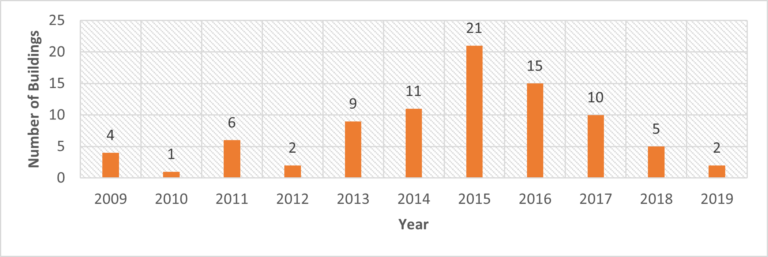Providing affordable, accessible, and adequate housing is one of the Government’s key agenda and commitment in its Bottom-up Economic Transformation Agenda (BETA). The government targets to increase housing production by 200,000 units a year while at the same time increasing the share of affordable housing from 2 per cent to 50 per cent.
But recent occurrences of buildings collapsing cast doubt on the sector’s ability to deliver adequate safe housing on such a large scale. Between 2009 and 2019, a total of 86 buildings valued at over Ksh 2.4 billion collapsed. The highest number was recorded in 2015 when 21 buildings collapsed (Figure 1). An estimated 200 people lost their lives in these incidents (National Construction Authority, 2019).
Figure 1: Number of collapsed buildings between 2009 and 2019 in Kenya

Source: National Construction Authority
The Kenya National Housing Policy (2004) recommends for development of safe and decent housing in Kenya and use of appropriate building materials. However, an audit conducted by the National Building Inspectorate in 2018 found that, out of 14,895 buildings sampled, 4.8 per cent were very dangerous; 72.3 per cent were classified as unsafe, 8.2 per cent were found to be in fair condition and 14.7 per cent were categorized as safe.
In 2019, Nairobi accounted for the highest number of collapsed buildings at 33 followed by Kiambu County at 14 (Figure 2). The reduction in the number of collapsed buildings post in 2015 was largely due to strict enforcement and the introduction of the e-construction permit in Nairobi. The National Construction Authority also embarked on an aggressive campaign to register contractors and construction workers.
Figure 2: Number of collapsed buildings by county in 2019

Data Source: NCA Report (2019)
Interventions in the Construction Sector
Institutional structures
To guarantee quality management in the construction sector, including the construction of buildings, the government, in 2011 formed the National Construction Authority (NCA) with the mandate to coordinate, regulate and build the capacity of the construction industry. NCA has ensured the enhancement of the quality of construction through the registration of projects, quality assurance checks across the country, and building the capacity of contractors and construction workers.
The NCA has recorded great improvement in the construction of buildings through the registration of projects, and quality checks across the country. However, several gaps in the construction sector persist, including non-compliance with set guidelines, the existence of multiple conflicting frameworks, the manual approval process, and inadequate awareness of the available database, which poses a problem to the sector.
Most non-compliance issues in the sector include using inappropriate construction material, poor workmanship attributed to inadequate skills, and unprofessional and ethical conduct of contractors. The NCA (2019) report shows that poor workmanship contributes to the highest percentage of collapsed buildings at 35 per cent, while the use of substandard construction materials stood at 28 per cent and unprofessional and unethical conduct of contractors at 34 per cent.
The multiple frameworks that guide and regulate the construction sector are at times in conflict with one another. There is low coordination among the various agencies involved in building control and regulation. The National Environment Management Authority (NEMA), the NCA and counties are the agencies involved in the building approval process, but their mandates are weakly coordinated. The limitation in coordination leads to delayed approvals. Construction industry laws and regulations have gaps on clarity of scope, leading to overlapping mandates, and there is no comprehensive policy framework to guide the sector. For example, both county officials and NCA officials visited separately one of three buildings that collapsed in November 2022. The building codes that are currently in use are outdated, having been drafted in 1968 and not anchored in law. There is inadequate quality assurance on construction techniques and materials.
The NCA has a database of qualified supervisors, contractors, and foremen, but this database is not widely known to the public. The Authority should therefore publicize its existence to encourage developers to use only accredited workmen. Poor workmanship is the single biggest cause of building collapse.
Policy and legal framework
There are multiple laws and policy documents that guide and regulate the construction sector. The Draft Construction Policy of 2019 was intended to provide a comprehensive policy for the sector in line with the Kenya Vision 2030 of creating a coordinated and developed construction industry, translating to growth and development. The policy notes that advancement in the industry can be achieved through the development of a critical mass of human resource capacity and building institutional capacity, quality management, and through research and innovation. The draft policy further aims to promote access to and use of data and information in decision-making.
An example of efforts to quicken the approval process in Nairobi County is the launch of an automated construction permit system, following assistance from the World Bank in 2015. The system was meant to improve efficiency in issuing construction permits, fostering best practices, and improving the inspection process by allowing the generation of reports of ongoing construction and profiling them according to risk. After its adoption, the cases of buildings collapsing declined gradually from a high of 21 in 2015 to 2 in 2019. The success in curtailing building collapse with the system has, however, been short-lived as the number of the building collapsing has begun rising with three collapsing in a span of a week in Nairobi in November 2022.
The introduction of the e-permit was a great achievement in the building approval process. However, manual application system still exists in all other counties, with an exception of Nairobi posing a challenge to the construction industry. The process is lengthy and entails physical visits to several offices for approval. The manual application processes mostly encourage non–compliance. The application requires a lot of paperwork, and the process is time-consuming and confusing. This can lead to delays in the application process, which can be frustrating and discouraging for the applicant.
Conclusions and Recommendations
For effective oversight of the sector, several measures must be undertaken. To promote compliance with the set guidelines, it is important that regulatory bodies engage all relevant stakeholders, including investors and public to emphasize the importance of safe construction practices.
The legal and policy frameworks must be updated to reflect current trends and best practices. These include finalizing and adopting the Draft National Building Code 2020 and the Draft Construction Policy of 2019 and changing the laws to mandate all agencies involved in the approval and regulation of construction in the country to work together. Agencies can utilize ‘Huduma Centre’ model to enhance coordination under one roof. This will help reduce the time taken for approvals and improve transparency in the permit issuance process.
The introduction of the e-permit system in Nairobi County saw a significant decrease in the number of buildings collapsing. To replicate the achievements witnessed with the adoption of the e-construction permit system, a single nationwide system should be adopted with modules for each county. The system will not only improve efficiency and profile buildings, but it will also act as a central repository for data concerning construction and buildings in the country.
The NCA has a database of qualified supervisors, contractors, and foremen. NCA may continually publicize and sensitize the public on the existence of the database and be empowered to conduct investigations and recommend prosecution where there is a suspected violation of construction laws and guidelines.
By John Kioko and Faith Kimaiyo, KIPPRA Young Professionals






